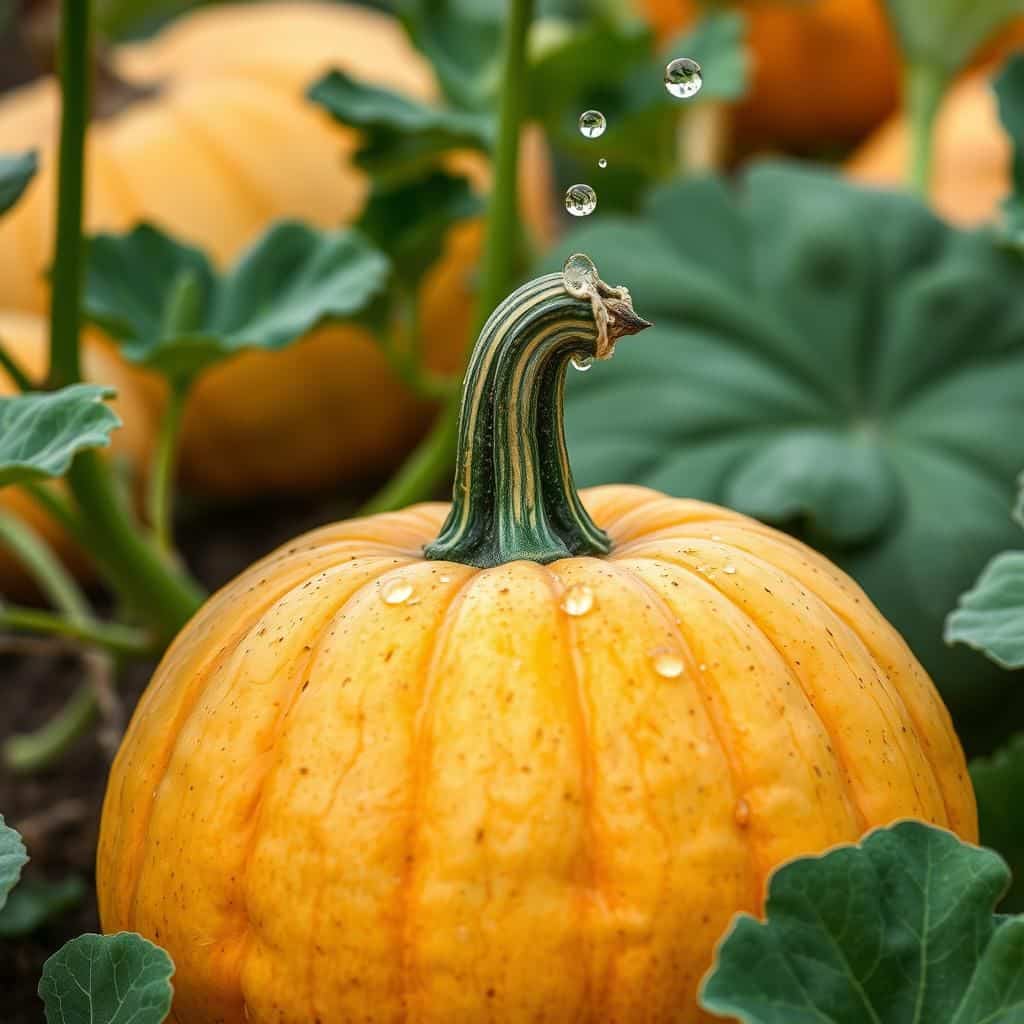Do Pumpkins Need a Lot of Water? Essential Tips for Growing Healthy Pumpkins

Growing pumpkins can be a rewarding venture for gardeners, but it raises an important question: do these vibrant gourds require a lot of water? Understanding the watering needs of pumpkins is crucial for achieving a bountiful harvest. Overwatering and underwatering can both lead to problems, affecting plant health, fruit quality, and overall yield. In this article, we will explore essential tips for providing the right amount of moisture to your pumpkin plants. From soil type to weather conditions, we will cover everything you need to know to ensure your pumpkins grow strong and healthy throughout their development.
Do Pumpkins Need a Lot of Water?
Pumpkins require a moderate amount of water to thrive during their growing season. While they do not need excessive watering, maintaining consistent moisture in the soil is crucial for their development. This is particularly important during the flowering and fruiting stages, as a lack of water can lead to poor fruit quality and even blossom drop. Generally, providing around 1 to 2 inches of water per week, either from rainfall or irrigation, ensures that the soil remains adequately moist without becoming waterlogged.
Optimal Watering Schedule
An optimal watering schedule for pumpkins can vary based on environmental conditions, but they typically need about 1 to 2 inches of water per week. During extremely hot weather or if the plants are newly transplanted, more frequent watering may be necessary to prevent stress. Conversely, in cooler conditions or particularly rainy seasons, you may need to adjust your watering to avoid over-saturation.
Signs of Underwatering
Signs of underwatering in pumpkin plants include wilting leaves, dry and cracking soil, and yellowing foliage. If you notice these symptoms, it is crucial to check the soil moisture and increase watering to ensure the plants receive enough water to support their growth. Proper hydration is essential, especially in the hot summer months.
Impact of Overwatering
While pumpkins need moisture, overwatering can be detrimental. It can lead to root rot and other fungal diseases, which can severely impact plant health. To prevent overwatering, ensure that the soil drains well, and only water when necessary. Monitoring soil conditions regularly will help maintain the right balance.
See also:
Soil Type and Water Retention
The type of soil you use plays a significant role in water retention. Sandy soils drain quickly and may require more frequent watering, while clay soils retain moisture but can lead to overwatering issues. A well-balanced mix, such as loamy soil, is ideal for growing pumpkins as it retains enough moisture while allowing for proper drainage.
Seasonal Watering Considerations
During the growing season, especially in the weeks leading up to harvest, you may need to adjust your watering routine based on rainfall and temperature. Early in the season, consistent watering promotes strong root development, while later in the season, monitoring water levels can help ensure that pumpkins mature optimally without compromising their quality.
| Watering Needs | Frequency | Signs of Stress |
|---|---|---|
| 1-2 inches per week | Weekly (more in hot weather) | Wilting, yellowing leaves |
| Soil moisture check | As needed based on conditions | Cracked soil, dry leaves |
Understanding the Water Requirements of Pumpkins
Pumpkins require a consistent and adequate supply of water throughout their growing season to achieve healthy growth and maximize fruit production. During the crucial germination and flowering stages, it is vital to provide about 1 to 2 inches of water per week. This can be achieved through irrigation or natural rainfall, but it's important to monitor the soil moisture levels closely. Ensuring that the soil remains moist but not waterlogged is essential; developing deep roots will be hindered if the plants are overwatered. Additionally, applying a layer of mulch can help retain soil moisture and regulate temperature, further supporting the pumpkin plants as they thrive.
The Importance of Soil Moisture for Pumpkins
Maintaining proper soil moisture is critical for pumpkin growth as it directly affects seed germination, root development, and overall plant health. Insufficient moisture can lead to stunted growth and reduced fruit yield, while excessive water can cause root rot and other plant diseases. Regularly checking the moisture level of the soil, especially in hot weather, will ensure that your pumpkin plants receive the hydration they need to thrive. Using tools like soil moisture meters can provide accurate readings and assist in determining when to water.
Best Watering Practices for Pumpkins
For the healthiest pumpkins, it's essential to adopt the best watering practices. Watering deeply and infrequently encourages deeper root systems which can withstand drought conditions better. Aim to water earlier in the morning to minimize evaporation and allow foliage to dry, reducing the risk of fungal diseases. When using a drip irrigation system, consider adjusting the flow rate according to the plants' growth stages to ensure optimal moisture levels are maintained.
See also:
Signs of Overwatering and Underwatering Pumpkins
Recognizing the signs of overwatering and underwatering is crucial for successful pumpkin cultivation. Overwatered plants may show signs like yellowing leaves, wilting despite moist soil, or root rot, while underwatered pumpkins will exhibit wilting, dry leaves, and stunted growth. Regularly observing your plants and assessing the soil conditions will enable you to adjust your watering schedule more effectively, ensuring your pumpkins remain healthy and productive.
Timing and Frequency of Watering Young Pumpkin Plants
When it comes to young pumpkin plants, timing and frequency of watering are crucial for their establishment. In the early stages, after planting, they should be watered every few days to keep the soil consistently moist. As the plants mature and develop deeper root systems, you can gradually reduce the frequency but increase the depth of watering sessions. This method not only helps establish a robust plant but also prepares it to better withstand drought periods later in the growing season.
Using Mulch to Retain Water for Pumpkin Growth
Utilizing mulch in your pumpkin patch is an effective strategy to help retain soil moisture. Applying a layer of organic mulch, such as straw or wood chips, around the base of the plants can significantly reduce water evaporation, maintain a more consistent soil temperature, and suppress the growth of weeds that compete for moisture. As the mulch breaks down, it also adds valuable nutrients to the soil, enhancing the overall growth conditions for your pumpkins.
Questions from Our Readers
Do pumpkins need a lot of water to grow?
Pumpkins do require a significant amount of water to grow effectively. Adequate moisture is crucial during their development, especially while they are setting fruit and during hot weather. Generally, they need 1 to 2 inches of water per week, either from rainfall or irrigation, to thrive.
How often should I water my pumpkin plants?
It's recommended to water pumpkin plants deeply about once a week, ensuring that they receive enough moisture to reach their roots. During particularly hot or dry spells, you may need to increase the frequency. Consistent watering helps prevent the plants from becoming stressed and ensures proper development.
See also:
What happens if pumpkins don't get enough water?
If pumpkins do not receive enough water, they can suffer from stunted growth and produce small fruits. Inadequate moisture can lead to blossom end rot, a common problem where the bottom of the pumpkin turns brown and soft. Additionally, lack of water can make the plants more susceptible to pests and diseases.
Can I overwater my pumpkin plants?
Yes, overwatering pumpkin plants can create problems as well. Excess moisture can lead to root rot and fungal diseases, which can compromise the health of the plants. It is essential to ensure that the soil has good drainage and to avoid soggy conditions to promote healthy growth.

If you want to read more articles like Do Pumpkins Need a Lot of Water? Essential Tips for Growing Healthy Pumpkins, we recommend you check out our Irrigation category.
Leave a Reply
Related Articles